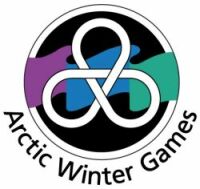Top Qs
Timeline
Chat
Perspective
Arctic Winter Games
Multi-sport competition From Wikipedia, the free encyclopedia
Remove ads
The Arctic Winter Games are a biennial multi-sport and indigenous cultural event involving circumpolar peoples residing in communities or countries bordering the Arctic Ocean.
Remove ads
History
Summarize
Perspective
The Arctic Winter Games were founded in 1969 under the leadership of Alaska Governor Walter J. Hickel, Stuart (Stu) M. Hodgson, Commissioner of the Northwest Territories, and James Smith, Commissioner of Yukon. The idea to "provide a forum where athletes from the circumpolar North could compete on their own terms, on their own turf" came from Cal Miller, an advisor with the Yukon team at the 1967 Canada Winter Games.
In 1970 in Yellowknife, Canada, 500 athletes, trainers and officials came together for the first Arctic Winter Games. The participants came from the Northwest Territories, Yukon, and Alaska. Participants now come from Alaska, Northern Alberta, Yukon, Nunavut, Nunavik, Northwest Territories, Greenland, Finland and Norway. The games in 2002 were the first jointly hosted Arctic Winter Games, by Nuuk, Greenland, and Iqaluit, Nunavut. During the 2023 games, Prince William held a video conference with nine participants.[2]
Designed to celebrate the unique sports and cultural heritage of the Arctic, the Games showcases a diverse range of competitions, traditional sports, and cultural events. With a strong emphasis on fostering friendship, cultural exchange, and athletic excellence, the Arctic Winter Games has become a platform for showcasing the talents and traditions of northern communities.
The next Arctic Winter Games are scheduled to take place in Whitehorse, Yukon from 8–15 March 2026.[3]
Remove ads
Nations
- Canada - five regions (Alberta North, Northwest Territories, Nunavik, Nunavut, Yukon)
- United States - one region (Alaska)
- Greenland
- Sápmi - the region stretches over four countries: Norway, Sweden, Finland, and Russia
Contingents
Summarize
Perspective
Since 2004 the same nine contingents have participated in the Arctic Winter Games. Another four contingents have taken part in the games throughout the games' history: Russia, Magadan, Tyumen and Chukotka. In the table below is an overview of each contingent's appearances throughout the games.[4][5][6] Prior to the 2000 Arctic Winter Games Nunavut was part of the Northwest Territories. After division in 1999, Nunavut competed as separate contingent.
Editions
Summarize
Perspective

Host cities have been in Canada, the United States, and Greenland.[7]


Remove ads
Hodgson Trophy
The Hodgson trophy for fair play and team spirit is awarded at the end of every games. The trophy is named for Stuart (Stu) Milton Hodgson, former Commissioner of the Northwest Territories.[10]
The past winners of the trophy are:[10]
Remove ads
Arctic Winter Games International Committee
The Arctic Winter Games International Committee consists of the following people[1]
- John Rodda - Alaska, president
- Leigh Goldie - Alberta, vice president
- John Flynn - Yukon, past president
- Ian Laegraee - Northwest Territories, secretary
- Kyle Seely - Nunavut, director
- Karl Davidsen - Greenland, director
- John Estle - Alaska, joint interim - technical director
- Alison Brown - Northwest Territories, joint interim - technical director
- Marie Cairns - Yukon, director
- Mariele dePuter - Nunavut, director
- Don Wilson - Alberta, Treasurer
- Jane Arychuk - Northwest Territories, director
- Moira Lassen - Yukon, executive director (ex-officio)
Remove ads
Sports disciplines
Summarize
Perspective
A total of 29 sports have been represented at the Arctic Winter Games. Arctic Sports, badminton, cross country skiing, ice hockey and volleyball are the only sports to be featured in all editions of the Arctic Winter Games.[11]
The table below shows the sports and the years in which they have been a part of the Arctic Winter Games programme.
- X = The sport was featured in this Arctic Winter Games.
- 12 = The sport was featured in this Arctic Winter Games. The number indicates the amount of medal-giving events in that sport.
- d = Demonstration sport with no medal-giving events.
- P = The sport is planned to be a part of an upcoming edition of the Arctic Winter Games.
- — = The sport did not feature in this edition of the Arctic Winter Games.
Remove ads
Arctic Winter Games alumni
- The Governor General of Canada, Michaëlle Jean, presented Aisa Pirti, a 19-year-old Inuk from Akulivik, Nunavik, with the National Aboriginal Role Model Award during a ceremony at Rideau Hall. Aisa has received 30 medals and five trophies for Inuit games in regional and circumpolar competitions, such as the Arctic Winter Games and the Eastern Arctic Summer Games.
See also
- World Eskimo Indian Olympics
- Nalukataq (traditional blanket toss celebrations)
- World Indigenous Games
- Traditional sports and games
Notes
- Originally to be hosted by Yamal-Nenets, Russia, but withdrawn by committee due to war against Ukraine. Yellowknife declined to host the games that year and Whitehorse stepped in.[9]
- Originally slated to be held in the Northwest Territories but Vince McKay, Municipal and Community Affairs Minister, said the territory would not be hosting the games.[9]
References
External links
Wikiwand - on
Seamless Wikipedia browsing. On steroids.
Remove ads

